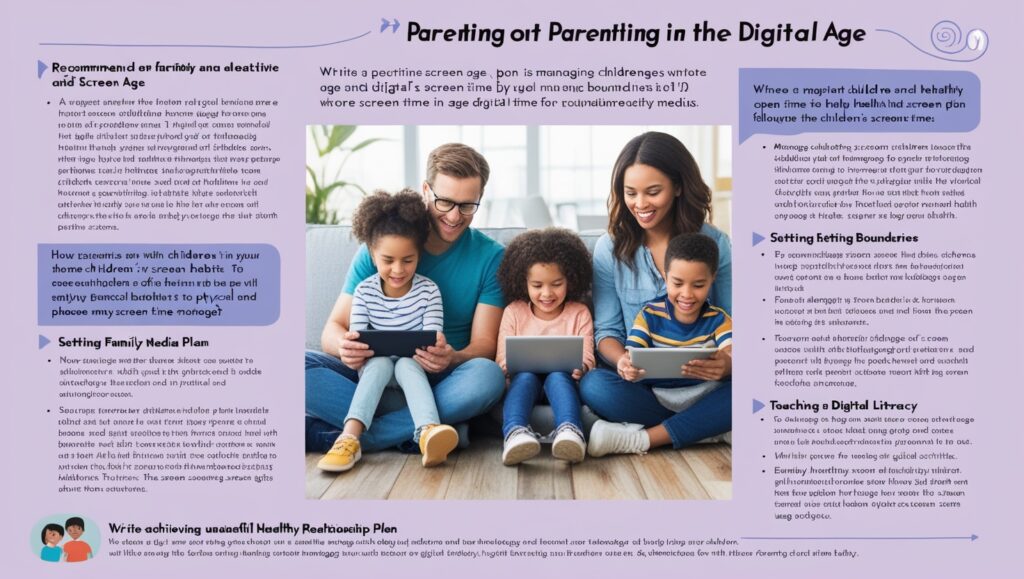Parenting in the Digital Age Navigating Screen Time
The digital age has revolutionized the way we live, work, and communicate. For parents, it has also introduced unique challenges, particularly in managing children’s screen time. Balancing the benefits of technology with its potential pitfalls requires a thoughtful and informed approach. In this blog, we’ll explore the nuances of screen time, its impact on children, and practical strategies for navigating it effectively.
Understanding Screen Time
Screen time refers to the amount of time spent using devices with screens, such as smartphones, tablets, computers, and televisions. While screens can be tools for learning, creativity, and connection, excessive or unmonitored usage can lead to negative consequences, including:
- Physical Health Issues: Eye strain, poor posture, and lack of physical activity.
- Mental Health Concerns: Anxiety, depression, and reduced attention span.
- Sleep Disruptions: The blue light from screens can interfere with melatonin production, affecting sleep quality.
- Impact on Social Skills: Overreliance on screens can hinder face-to-face interactions and emotional development.
Benefits of Screen Time (When Used Wisely)
It’s not all doom and gloom. With moderation and purpose, screen time can offer:
- Educational Opportunities: Interactive apps and educational videos can enhance learning.
- Skill Development: Coding, design, and problem-solving skills can be honed through specific digital platforms.
- Connectivity: Video calls and social media help children stay connected with friends and family.
- Entertainment: Access to age-appropriate movies, games, and music can provide relaxation and fun.
Recommended Screen Time Guidelines
While every family is unique, organizations like the American Academy of Pediatrics (AAP) provide general guidelines:
- 0-18 months: Avoid screen time except for video calls.
- 18-24 months: Introduce high-quality educational content with parental supervision.
- 2-5 years: Limit screen time to 1 hour per day of high-quality programming.
- 6 years and older: Establish consistent limits to ensure screen time doesn’t interfere with sleep, physical activity, and other essential activities.
Practical Strategies for Managing Screen Time
1. Create a Family Media Plan
Develop a media plan that outlines screen time rules, such as:
- Specific times for screen use (e.g., no screens during meals).
- Designated screen-free zones (e.g., bedrooms).
- Approved apps, games, and websites
2. Set an Example
Children model their behavior after adults. By practicing mindful screen use yourself, you can set a positive example. Avoid excessive phone usage in front of your children and prioritize face-to-face interactions.
3. Encourage Alternative Activities
Offer engaging non-digital alternatives, such as:
- Outdoor play and physical activities.
- Reading books or storytelling.
- Arts and crafts, puzzles, and board games.
- Family outings and quality time together.
4. Use Technology Wisely
- Parental Controls: Leverage parental control tools to monitor and limit screen time.
- High-Quality Content: Choose educational and age-appropriate apps and programs.
- Co-Engagement: Watch shows or play games together to make screen time interactive and bonding.
5. Teach Digital Literacy
Help children understand the importance of:
- Online Safety: Avoid sharing personal information and recognizing scams.
- Critical Thinking: Evaluate the credibility of online information.
- Digital Etiquette: Practice kindness and respect in online interactions.
Signs of Unhealthy Screen Time Habits
Watch for red flags that may indicate problematic screen use, such as:
- Irritability or anxiety when away from screens.
- Decline in academic performance or interest in hobbies.Neglecting physical health or social relationships.
- If you notice these signs, consider revisiting screen time rules and seeking professional guidance if necessary.
The Role of Communication
Open and honest communication is key to managing screen time effectively. Discuss with your children:
- Why limits are important for their health and well-being.
- The benefits and risks of screen usage.
- Their favorite online activities and how to balance them with offline pursuits.
Final Thoughts
Parenting in the digital age comes with its set of challenges, but it also offers incredible opportunities to raise tech-savvy, well-rounded individuals. By setting clear boundaries, promoting healthy habits, and maintaining open communication, parents can guide their children toward a balanced relationship with technology.
Remember, the goal isn’t to eliminate screens but to ensure they are used mindfully and purposefully. As technology continues to evolve, so too will our strategies for navigating it. Together, we can create a healthy digital environment for our children, fostering growth, learning, and connection.
What strategies have worked for your family? Share your tips and experiences in the comments below!

